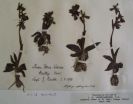(Press-News.org) Plants picked up to 150 years ago by Victorian collectors and held by the million in herbarium collections across the world could become a powerful – and much needed – new source of data for studying climate change, according to research published this week in the British Ecological Society's Journal of Ecology.
The scarcity of reliable long-term data on phenology – the study of natural climate-driven events such as the timing of trees coming into leaf or plants flowering each spring – has hindered scientists' understanding of how species respond to climate change.
But new research by a team of ecologists from the University of East Anglia (UEA), the University of Kent, the University of Sussex and the Royal Botanic Gardens, Kew shows that plants pressed up to 150 years ago tell the same story about warmer springs resulting in earlier flowering as field-based observations of flowering made much more recently.
The team examined 77 specimens of the early spider orchid (Ophrys sphegodes) collected between 1848 and 1958 and held at the Royal Botanic Gardens, Kew and the Natural History Museum in London. Because each specimen contains details of when and where it was picked, the researchers were able to match this with Meteorological Office records to examine how mean spring temperatures affected the orchids' flowering.
They then compared these data with field observations of peak flowering of the same orchid species in the Castle Hill National Nature Reserve, East Sussex from 1975 to 2006, and found that the response of flowering time to temperature was identical both in herbarium specimens and field data. In both the pressed plants and the field observations, the orchid flowered 6 days earlier for every 1oC rise in mean spring temperature.
The results are first direct proof that pressed plants in herbarium collections can be used to study relationships between phenology and climate change when field-based data are not available, as is almost always the case.
According to the study's lead author, PhD student Karen Robbirt of UEA: "The results of our study are exciting because the flowering response to spring temperature was so strikingly close in the two independent sources of data. This suggests that pressed plant collections may provide valuable additional information for climate-change studies."
"We found that the flowering response to spring temperature has remained constant, despite the accelerated increase in temperatures since the 1970s. This gives us some confidence in our ability to predict the effects of further warming on flowering times."
The study opens up important new uses for the 2.5 billion plant and animal specimens held in natural history collections in museums and herbaria. Some specimens date back to the time of Linnaeus (who devised our system of naming plants and animals) 250 years ago.
Co-author Professor Anthony Davy of UEA says: "There is an enormous wealth of untapped information locked within our museums and herbaria that can contribute to our ability to predict the effects of future climate change on many plant species. Importantly it may well be possible to extend similar principles to museum collections of insects and animals."
Phenology – or the timing of natural events – is an important means of studying the impact of climate change on plants and animals.
"Recent climate change has undoubtedly affected the timing of development and seasonal events in many groups of organisms. Understanding the effects of recent climate change is a vital step towards predicting the consequences of future change. But only by elucidating the responses of individual species will we be able to predict the potentially disruptive effects of accelerating climate change on species interactions," he says.
Detecting phenological trends in relation to long-term climate change is not straightforward and relies on scarce long-term studies. "We need information collected over a long period to enable us confidently to identify trends that could be due to climate change. Unfortunately most field studies are relatively brief, so there are very few long-term field data available," Professor Davy explains
INFORMATION:
Ecologists find new clues on climate change in 150-year-old pressed plants
2010-09-22
ELSE PRESS RELEASES FROM THIS DATE:
Ultrashort laser ablation enables novel metal films
2010-09-22
Washington, D.C. (September 21, 2010) -- Laser ablation is well known in medical applications like dermatology and dentistry, and for more than a decade it has been used to vaporize materials that are difficult to evaporate for high-tech applications like deposition of superconductors. Now researchers in the Journal of Applied Physics, which is published by the American Institute of Physics have studied the properties of femtosecond laser ablation plumes to better understand how to apply them to specialized films.
Salvatore Amoruso at University of Naples, Italy and ...
Certain doped-oxide ceramics resist Ohm's Law
2010-09-22
Washington, D.C. (September 21, 2010) -- For months, Anthony West could hardly believe what he and his colleagues were seeing in the lab -- or the only explanation for the unexpected phenomena that seemed to make sense.
Several of the slightly doped high-purity barium titanate (BT) ceramics his research group was investigating were not following the venerable Ohm's Law, which relates electrical voltage to current and resistance. Applying or removing a voltage caused a gradual change in the materials' electrical resistance. The new effect was seen consistently regardless ...
Progress toward terabit-rate high-density recording
2010-09-22
Washington, D.C. (September 21, 2010) -- Research is closing in on the next-generation of ultra-high-density magneto-optical storage devices that could store more than 6,000 Terabits (6 petabits) of data, more than 70 times the contents of the entire U.S. Library of Congress, on a single 5-inch disc. Yet the vast storage amount is limited by the ability to write data quickly enough to the device. In the Journal of Applied Physics, researchers at Sun Yat-Sen University in China have demonstrated a way to record on ferromagnetic films using a laser-assisted ultrafast magnetization ...
Watching electrons move in real time
2010-09-22
Washington, D.C. (September 21, 2010) -- At its most basic level, understanding chemistry means understanding what electrons are doing. Research published in The Journal of Chemical Physics not only maps the movement of electrons in real time but also observes a concerted electron and proton transfer that is quite different from any previously known phase transitions in the model crystal, ammonium sulfate. By extending X-ray powder diffraction into the femtosecond realm, the researchers were able to map the relocation of charges in the ammonium sulfate crystal after they ...
Stress before cancer therapy could help deadly cells survive treatment, lead to disease recurrence
2010-09-22
COLUMBUS, Ohio – Patients who experience physical or psychological stress – including rigorous exercise – one or two days before a cancer treatment might be unknowingly sabotaging their therapy, new research suggests.
Stress in the body – even physical stress caused by intense exercise – activates a stress-sensitive protein that can spark a series of events that allow cancer cells to survive such treatments as chemotherapy and radiation, according to the research.
Though the study involved a series of experiments in breast cancer cell cultures, the researchers say ...
Complex brain landscape controls speech
2010-09-22
Broca's region is classically regarded as the motor centre for speech. Our ability to form phonemes and words is controlled here. According to the maps of the cerebral cortex developed by Korbinian Brodmann, which are still in use today, Broca's region is composed of two areas. Over the last few years, however, researchers have begun to question this subdivision as a result of experience gained in clinical studies and the findings of magnetic resonance imaging analyses. "Lesions in Broca's region could result in a dozen different language problems," says Professor Katrin ...
Wake up your brain
2010-09-22
For advanced activities of our daily life (such as driving a car, or seeing a movie), to be awake is important. It has been known so far that neuropeptide in the brain called "Orexin"controls sleep and awakening besides appetite. Here, the research group led by Dr. Akihiro Yamanaka, National Institute for Physiological Sciences (NIPS), found that orexin-releasing neurons have the self-excitation mechanism that activate each other among them, and maintain awaking. From this result, the application to doze prevention or insomnia treatment can be expected. It is reported in ...
Dancing robot swan triggers emotions
2010-09-22
The Dying Swan is sometimes moving smoothly and gently, sometimes in a dramatic and fiery manner, as Tchaikovsky´s majestic music from the ballet Swan Lake is playing. Yet this is no ordinary ballet dancer, but a robot in the form of a swan, created at Mälardalen University and choreographed by professional dancer Åsa Unander-Scharin.
The swan robot´s just over four-minute-long dance has so far been seen only by a select few. But it has already made a big impression. Tearful eyes and words like "touching", "fascinating" and "beautiful" are some of the reactions.
- We ...
Paper highlights need for new studies and guidelines around oxygen therapy during MI
2010-09-22
Sophia Antipolis, 21 September 2010: The European Society of Cardiology (ESC) welcomes a paper published today in the Journal of the American College of Cardiology (JACC )(1) highlighting concerns over the use of oxygen therapy during MI in patients with normal oxygen levels. The publication adds to calls for revision of the STEMI guidelines around oxygen therapy and for a prospective, large scale randomised trials, issues that were both first raised in a Cochrane Review published in June (2).
"The upcoming ESC Clinical Practice Guidelines for the management of STEMI, ...
Genomic 'haircut' makes world's tiniest genome even smaller: UBC research
2010-09-22
The world's tiniest nuclear genome appears to have "snipped off the ends" of its chromosomes and evolved into a lean, mean, genome machine that infects human cells, according to research published today by University of British Columbia scientists.
Until recently, E. cuniculi, a parasitic fungus commonly found in rabbits that can also be fatal to immunocompromised humans, has been widely regarded as having the smallest known nuclear genome. At 2.9 millions base pairs (Mbp) and approximately 2,000 genes, the genome of E. cuniculi is less than one-two thousandth the size ...

